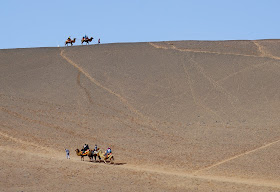Before stopping for a bite to eat, our buses drove into the Flaming Mountains. I don't know if they got that name because of the red sandstone that forms them, or because this is the hottest spot in China, frequently reaching over 120℉ (but with a surface temperature of over 150℉), or because the eroded sandstone cliffs look like flames:
As we drove farther up the road, the landscape varied somewhat, but the absolute lack of vegetation did not:
We came to a large parking lot that appeared to be the end of the road. The scenery was very dramatic:
. . . and we were stunned to find a river running down a gorge lushly lined with trees.
It is hard to imagine where this water is coming from.
There was a small camel-riding operation near the parking lot, but unfortunately we didn't have time for an excursion:
At the base of the camel-riding hill we noticed an interesting sculpture:
He is followed by friends he picked up on his journey:
My favorite character is Pigsy. You can probably pick him out, right?
Proof that I was there:
Various dome-topped structures punctuated the landscape. One looked like a mosque:
. . . another like a storage shed:

. . . and a third like the Chinese version of Snow White's home with the Seven Dwarfs:
Our guide pointed out these stairs that lead to the top of the mountain. When it is 120° outside, climbing these stairs is an exercise (no pun intended) in self-discipline and sacrifice. I think it is something like climbing the Scala Sancta (Holy Stairs) in Rome on one's knees as a sign of devotion:
It was exhausting just to contemplate the idea, let alone do it, and I was grateful that we could forgo the opportunity in favor of some refreshment back in Turpan.
Here is our Uyghur guide, AJ, whom we liked a lot. leading us into the "Mahmut Grape Music Manor" for some fruit tasting.
We were welcomed by some local musicians and, surprise surprise, a "Welcome Fun for Less Tours" banner!
They had quite the spread ready for us. It included several colors of raisins, dried kiwi, apples, dates, nuts, grapes, persimmons, bananas, watermelon, and several fruits I could not identify. There were cookies and cakes too, but the Chinese, at least in this region, fail at desserts.
These are the classic products of the Xinjiang Province: various colors of raisins. I was suprised to learn that about 160 varieties of grapes are grown in this region of China, and the parched climate makes it the perfect place to turn the grapes into raisins.
There was the traditional flat bread, which looks tasty but really wasn't:
And there was this masterpiece of swirled strips of crunchy bread, a cross between unsalted pretzels and hard breadsticks. It also was much better to look at than to eat:
While we snacked, we enjoyed more of the local music, along with a little dancing:
These were some very unusual instruments, the first of many strange and unfamiliar ones we would see on this trip:
This woman's neon pink dress was quite the contrast to the earth tones that surrounded her, and her dancing was fun to watch. The child, who I think is her daughter, liked getting in on the action:
And I think this guy, who popped up for one very dramatic dance, must be her husband.
I came home intrigued by the story of the Monkey King and his motley band. His story is told in a 16th century Chinese novel entitled Journey to the West, one of group that is known as "The Four Great Classical Novels" of Chinese literature. A 1942 English translation by Arthur Waley entitled Monkey is available, but is is over 300 pages long, and I decided I wasn't that interested in what may be the most popular Chinese novel of all time. Yeah, I know. I'm shallow.
Our lecturer Michael Wilcox suggested that we look for a children's version of the story, and I decided that was more my style. An Amazon search led me to purchase The Monkey King: A Classic Chinese Tale for Children, written by David Seow and illustrated by Lak-Khee Tay-Audouard. I also purchased The Journey to the West: Birth of the Monkey King by Kathryn Lin.
The two stories are quite different, an indication to me of the complexity of the original tale. I enjoyed getting to know the feisty, mischievous monkey a little better and look forward to introducing him to my grandchildren. In particular, I think Tay-Audouard's wonderfully creative illustrations in The Monkey King will inspire their artistic interests.
































How you find time for all of this extra reading and literary adventure blows my mind. I had no clue you had ventured into the land of the monkey king. We just scratched the surface of Western China. So much more I would like to see and do there.
ReplyDeleteWell, they ARE children's books. It didn't take much time!
DeleteIt is so amazing that you are traveling through this place that looks like the Mohave Desert, and up pop a series of statues and houses and something a la Virgin River Gorge. Nothing is as it seems.
ReplyDelete